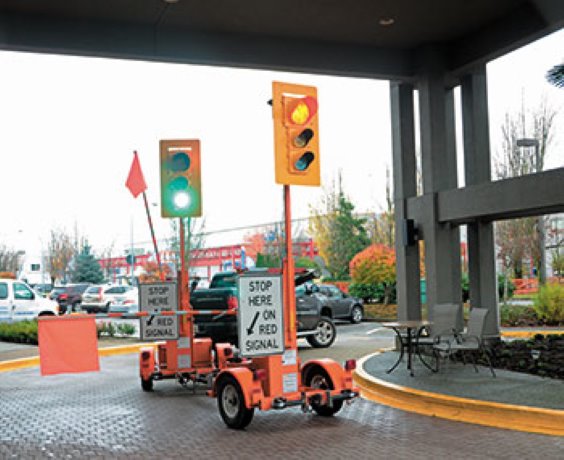A new type of automated traffic signal could improve worksite safety for flaggers in high risk situations.
Peter Vieveen, founder and president of Port Colborne, Ontario-based North America Traffic Inc., was in the Lower Mainland to demonstrate his company’s RCF 2.4s portable traffic signal.
The device, which features three signal heads and a 10-foot parking-lot-style gate-arm, is for traffic control in maintenance and construction work.
Cheralee Miket, the B.C. Construction Safety Alliance’s (BCCSA) traffic control persons (TCP) program co-ordinator, attended one of the demonstrations.
“They are pretty neat machines,” said Miket.
“They are remote-operated, so an equipment operator could use them if need be. He (Vieveen) demonstrated them in a parking lot, but I would love to see them in a real-life scenario.”
What makes the RCF 2.4s different is its gate-arm.
Other units on the market and in use in B.C. have the signal lights, but the gate arm, which blocks traffic is unique.
Vieveen said his mechanized traffic control device was the first one to incorporate such an arm.
The “traffic light on wheels” can be operated manually or on pre-set cycle times; has a built-in conflict monitor that eliminates the chance of displaying two green signals at the same time; and works at temperatures from -40 Celsius to +50 Celsius.
He said the device is being used across Canada and the United States and is included in both the Canadian and U.S. Manual of Uniform Traffic Control Devices (MUTCD).
Vieveen said he developed his first automatic traffic control device in 1993, when he was an estimator for road, sewer and bridge construction contractors.
“Whenever I heard of a flagger getting hit by a vehicle, I felt compelled to build a machine that would improve safety and, at the same time, reduce costs in construction work zones,” he said.
Vieveen said the RCF 2.4s portable traffic signal provides a clear stop-and-go message to motorists.
“The control arm is an added measure of safety, and prevents motorists from entering the work zone when the traffic light is red,” he said.
“Flaggers could operate it from a safe location, far away from speeding vehicles.”
Vieveen said in work zones that are longer than 300 meters, each portable traffic signal can be operated by radio remote control from a safe location by a traffic control person, as if it were a stop/slow paddle.
“When it is operated like that, there are no problems with not having a clear line of sight, and no flagger jobs are lost,” he said.
For work zones shorter than 300 meters, a single traffic control person can operate two portable traffic signals from a safe location with a radio remote control.
“Right now, some very short work zones use only one flagger with a stop/slow paddle, used in conjunction with a lane closure vehicle,” he said.
When the RCF 2.4s is used in this manner, no flagger jobs are lost. But in work zones where two flaggers would be used, one job is lost.
Vieveen said the controller in his portable traffic signal is not an off-the shelf product.
“It is custom designed, programmed and manufactured to our own specifications, so that it… can be operated in severe cold and inclement weather, when it is difficult to push buttons on the front of the PLC (programmable logic controller) panel,” he said.
In addition to portable traffic signals, North America Traffic manufactures and sells automatic flagger assistance devices and flashing beacons.
Todd Wood, a superintendent with Knappett Industries, a civil contractor based in Nanaimo, said his company is using two North America Traffic’s portable traffic signals, but those models don’t have a gate arm.
Knappett is renting the units from JSK Traffic Control Services on Vancouver Island.
“We’re using them on a watermain installation down the middle of a windy and hilly road in a rural area outside Nanaimo,” he said.
“They’re about 150-180 metres apart and we use them nights and weekends, when the flaggers aren’t working.”
Mike McKenna, the BCCSA executive director, said the alliance is interested in knowing more about automatic traffic management and traffic control, especially as it concerns protecting traffic control personnel.
“We need to do more research on mechanized traffic controls to find out how best to use them,” McKenna said.











Recent Comments
comments for this post are closed